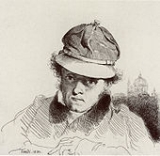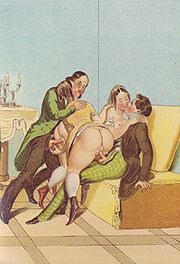
Peter Fendi
Encyclopedia

Austrians
Austrians are a nation and ethnic group, consisting of the population of the Republic of Austria and its historical predecessor states who share a common Austrian culture and Austrian descent....
court painter
Court painter
A court painter was an artist who painted for the members of a royal or noble family, sometimes on a fixed salary and on an exclusive basis where the artist was not supposed to undertake other work. Especially in the late Middle Ages, they were often given the office of valet de chambre...
, portrait
Portrait
thumb|250px|right|Portrait of [[Thomas Jefferson]] by [[Rembrandt Peale]], 1805. [[New-York Historical Society]].A portrait is a painting, photograph, sculpture, or other artistic representation of a person, in which the face and its expression is predominant. The intent is to display the likeness,...
and genre painter
Genre painting
Genre works, also called genre scenes or genre views, are pictorial representations in any of various media that represent scenes or events from everyday life, such as markets, domestic settings, interiors, parties, inn scenes, and street scenes. Such representations may be realistic, imagined, or...
, engraver, and lithographer. He was one of the leading artists of the Biedermeier
Biedermeier
In Central Europe, the Biedermeier era refers to the middle-class sensibilities of the historical period between 1815, the year of the Congress of Vienna at the end of the Napoleonic Wars, and 1848, the year of the European revolutions...
period.
Life
Peter Fendi was born in ViennaVienna
Vienna is the capital and largest city of the Republic of Austria and one of the nine states of Austria. Vienna is Austria's primary city, with a population of about 1.723 million , and is by far the largest city in Austria, as well as its cultural, economic, and political centre...
on 4 September 1796 to Joseph and Elizabeth Fendi. His father was a schoolmaster. He fell from a changing table as an infant, an accident which caused irreparable damage to his spine
Vertebral column
In human anatomy, the vertebral column is a column usually consisting of 24 articulating vertebrae, and 9 fused vertebrae in the sacrum and the coccyx. It is situated in the dorsal aspect of the torso, separated by intervertebral discs...
. Fendi demonstrated a talent for drawing from childhood. He was admitted to the St. Anna's Academy of Fine Art
Academy of Fine Arts Vienna
The Academy of Fine Arts Vienna is an institution of higher education in Vienna, Austria.- History :The Academy of Fine Arts Vienna was founded in 1692 as a private academy by the court-painter Peter Strudl, who became the Praefectus Academiae Nostrae. In 1701 he was ennobled as Baron of the Empire...
in 1810 at the age of thirteen, where he studied for three years under Johann Martin Fischer, Hubert Maurer
Hubert Maurer
Hubert Maurer was an Austrian painter, draughtsman, and teacher.Maurer was born in the Lengsdorf quarter of Bonn. He specialized in portraits and religious-themed works. Later in life he taught at the Vienna Academy of Fine Arts, where some of his students were Moritz Michael Daffinger, Peter...
and Johann Baptist von Lampi the Elder
Johann Baptist von Lampi the Elder
Giovanni Battista Lampi the Elder was an Austrian historical and portrait painter....
.
Fendi met Joseph Barth
Joseph Barth
Joseph Barth October 28, 1746, Valletta, Malta - April 7, 1818, Vienna, Austria, was a notable 18th century ophthalmologist.-Education:Anatomical & Surgical School at Sacra Infermeria, Valletta , Santo Spirito Hospital in Rome , University of Vienna...
, an art collector and the personal ophthalmologist of Joseph II
Joseph II, Holy Roman Emperor
Joseph II was Holy Roman Emperor from 1765 to 1790 and ruler of the Habsburg lands from 1780 to 1790. He was the eldest son of Empress Maria Theresa and her husband, Francis I...
, and through Barth's connections to other influential artists, in 1818 Fendi found a job at the Imperial Gallery of Coins and Antiquities, where he worked as a draughtsman and engraver. Fendi received a gold medal in 1821 for his oil-painting Vilenica
Vilenica
Vilenica Cave or Vilenica Cave at Lokev is the oldest show cave in Europe. The first tourists to the cave were recorded in 1633. It is located next to the village of Lokev in the municipality of Sežana on the Karst Plateau in southwestern Slovenia. Until the mid-19th century it was known as the...
, and was elected a member of the Academy of Fine Arts Vienna
Academy of Fine Arts Vienna
The Academy of Fine Arts Vienna is an institution of higher education in Vienna, Austria.- History :The Academy of Fine Arts Vienna was founded in 1692 as a private academy by the court-painter Peter Strudl, who became the Praefectus Academiae Nostrae. In 1701 he was ennobled as Baron of the Empire...
in 1836.
Both nobles and commoners occasionally employed Fendi to give instruction in drawing and painting, and later in life teaching took up more of his time; his pupils included Carl Schindler and Johann Friedrich Treml. He died on 28 August 1842.
Works
Fendi painted in oilOil painting
Oil painting is the process of painting with pigments that are bound with a medium of drying oil—especially in early modern Europe, linseed oil. Often an oil such as linseed was boiled with a resin such as pine resin or even frankincense; these were called 'varnishes' and were prized for their body...
and watercolours
Watercolor painting
Watercolor or watercolour , also aquarelle from French, is a painting method. A watercolor is the medium or the resulting artwork in which the paints are made of pigments suspended in a water-soluble vehicle...
, as well as working with printing
Printing
Printing is a process for reproducing text and image, typically with ink on paper using a printing press. It is often carried out as a large-scale industrial process, and is an essential part of publishing and transaction printing....
, etching
Etching
Etching is the process of using strong acid or mordant to cut into the unprotected parts of a metal surface to create a design in intaglio in the metal...
, lithography and wood carving
Wood carving
Wood carving is a form of working wood by means of a cutting tool in one hand or a chisel by two hands or with one hand on a chisel and one hand on a mallet, resulting in a wooden figure or figurine, or in the sculptural ornamentation of a wooden object...
. Multicolored prints by Fendi are considered pioneering achievements in the field of lithography. Fendi is remembered for his genre scenes, influenced by Dutch painters such as Adriaen Brouwer
Adriaen Brouwer
Adriaen Brouwer was a Flemish genre painter active in Flanders and the Dutch Republic in the seventeenth century.-Biography:...
, Adriaen van Ostade
Adriaen van Ostade
Adriaen van Ostade was a Dutch Golden Age painter of genre works.-Life:...
and Rembrandt. Other influences on Fendi's artistic development included the works of Italians such as Giovanni Bellini
Giovanni Bellini
Giovanni Bellini was an Italian Renaissance painter, probably the best known of the Bellini family of Venetian painters. His father was Jacopo Bellini, his brother was Gentile Bellini, and his brother-in-law was Andrea Mantegna. He is considered to have revolutionized Venetian painting, moving it...
, Tintoretto
Tintoretto
Tintoretto , real name Jacopo Comin, was a Venetian painter and a notable exponent of the Renaissance school. For his phenomenal energy in painting he was termed Il Furioso...
, Titian
Titian
Tiziano Vecelli or Tiziano Vecellio Tiziano Vecelli or Tiziano Vecellio Tiziano Vecelli or Tiziano Vecellio (c. 1488/1490 – 27 August 1576 better known as Titian was an Italian painter, the most important member of the 16th-century Venetian school. He was born in Pieve di Cadore, near...
, and Paolo Veronese
Paolo Veronese
Paolo Veronese was an Italian painter of the Renaissance in Venice, famous for paintings such as The Wedding at Cana and The Feast in the House of Levi...
, which he saw on a trip to Venice in 1821. He is also well-known for his portraits of the aristocracy and his erotic paintings. His watercolors depict almost all possible sex positions.
His works are preserved in the Albertina Museum
Albertina, Vienna
The Albertina is a museum in the Innere Stadt of Vienna, Austria. It houses one of the largest and most important print rooms in the world with approximately 65,000 drawings and approximately 1 million old master prints, as well as more modern graphic works, photographs and architectural drawings...
, the Austrian Gallery
Österreichische Galerie Belvedere
The Österreichische Galerie Belvedere is a museum housed in the Belvedere palace, in Vienna, Austria.The art collection includes masterpieces from the Middle Ages and Baroque until the 21st century, though it focuses on Austrian painters from the Fin de Siècle and Art Nouveau period...
in the Belvedere
Belvedere (palace)
The Belvedere is a historical building complex in Vienna, Austria, consisting of two Baroque palaces the Upper and Lower Belvedere, the Orangery, and the Palace Stables. The buildings are set in a Baroque park landscape in the 3rd district of the city, south-east of its centre. It houses the...
, Kunsthistorisches Museum
Kunsthistorisches Museum
The Kunsthistorisches Museum is an art museum in Vienna, Austria. Housed in its festive palatial building on Ringstraße, it is crowned with an octagonal dome...
, and in the collections of the Prince of Liechtenstein in Vaduz
Vaduz
Vaduz is the capital of the principality of Liechtenstein and the seat of the national parliament. The town, located along the Rhine, has about 5,100 inhabitants , most of whom are Roman Catholic. Its cathedral is the seat of a Roman Catholic archbishop....
.

